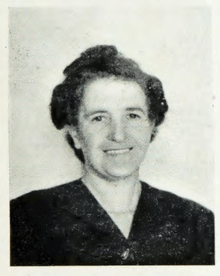Frances Heywood
Frances Heywood BSc, PhD, MInstMet (14 April 1902 – 18 September 1994) was a British metallurgist and engineer.
Frances Heywood | |
|---|---|
 | |
| Born | 14 April 1902 |
| Died | 18 September 1994 |
| Nationality | British |
| Education | PhD |
| Occupation | Engineer |
Biography
Heywood was born Frances Dora Weaver in Brentford, North east London, to an itinerant Methodist preacher. Her family followed her father so she attended Bradford Girls' Grammar School and Sheffield High School in Yorkshire. Heywood won the Arnott Scholarship which allowed her to get a degree in chemistry from Bedford College, University of London in 1924. After college she got a position as Assistant Metallurgist in Harley, Surrey for the Lanston Monotype Company Ltd. while she was there, the mechanical team assisted her to keep her motorbike maintained. She used it to commute to work. In 1926 Heywood became a member of the Women’s Engineering Society and joined the council in 1928.[1][2][3]
Heywood married Dr Harold Heywood in 1932. She retired from work on her marriage and they had 3 children. She continued to be an active researcher and a member of the Women's Engineering Society and spoke at engineering conferences.[4] She emphasized how women had been involved in engineering and metallurgy by pointing to the 1840 census which listed 469 female blacksmiths and 322 women smelters. Heywood also supported the education of women and contributed to the Central Employment Bureau girl's career guide on engineering. She was on the board of a variety of schools and colleges which included Bedford College and Dartford Technical College. Heywood went on to become president of the Women's Engineering Society in 1948, succeeding Dr. Winifred Hackett and succeeded by Sheila Leather.[1][5][3]
Research
She wrote about her work at the company which she submitted to The Woman Engineer in 1927. She began to start on her PhD, about tin-based alloys in the 1930s and completed it in 1935. Her funding came from the International Tin Research and Development Association. Part of the finance came from John Horace Fry of Frys Metal Foundries. Her research was thought the definitive work on the interaction of white metal alloy composition with the process of casting and the influence of impurities in the alloys. With herphotomicrographs of etched samples Heywood demonstrated that liquid metal stratifies significantly in alloys such as type face metals. She published on her research and was widely cited.[1][6][7][8][3]
She took up oil painting in later life. Heywood died in 1994.[1]
References and sources
- "32: Frances Dora Heywood". Magnificent Women. 1902-04-14. Retrieved 2020-05-17.
- "Frances D. Weaver". Graces Guide. 2020-05-17. Retrieved 2020-05-17.
- "The Woman Engineer Vol 6". The IET. Retrieved 2020-05-17.
- "from on November 3, 1955 · Page 6". Newspapers.com.
- "Report on the papers of Professor Harold Heywood (1905-1971)". The National Archives. 2008-12-18. Retrieved 2020-05-17.
- "Frys Metal Foundries". Graces Guide. 1923-02-16. Retrieved 2020-05-17.
- "METALLURGICAL ABSTRACTS" (PDF).
- Sanderson, Michael (1972). "Research and the Firm in British Industry, 1919-39". Science Studies. 2 (2): 107–151. doi:10.1177/030631277200200201. JSTOR 284511.